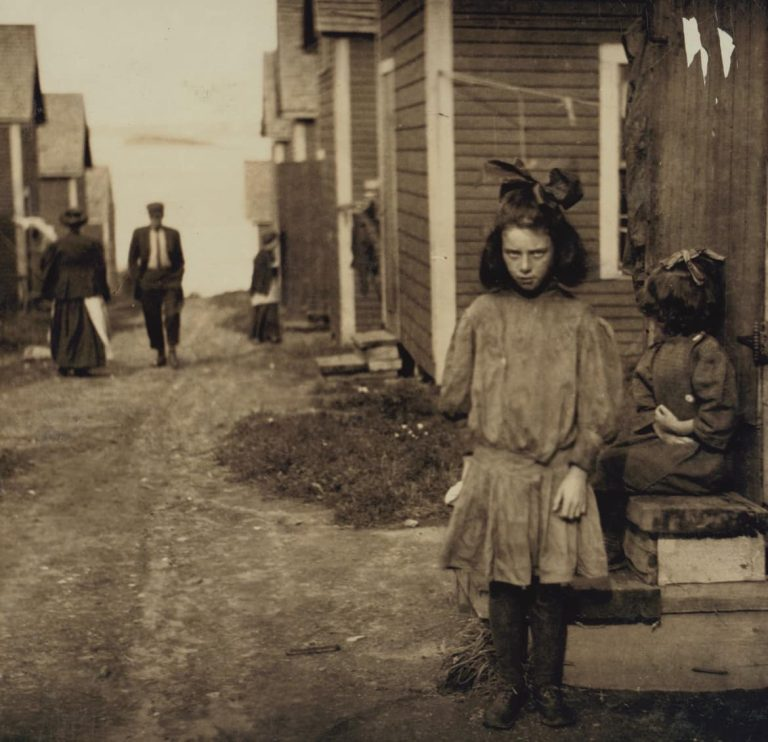The early 20th century was a time of relentless labor for many working-class families in America. In an era defined by industrial expansion and economic struggle, children like Nan de Gallant became symbols of perseverance amid harsh realities. At just nine years old, Nan worked in the Seacoast Canning Co. in Eastport, Maine, alongside her family, embodying the spirit and sacrifices of her generation. Her story offers a vivid snapshot of factory life in 1911, shedding light on the challenges faced by countless families striving to make ends meet.
The Daily Grind of a Factory Worker’s Life

For the de Gallants, summers weren’t a time for leisure; they were a season of intense labor. The family temporarily relocated from Perry, Maine, to Eastport during the peak canning season, when sardine factories hummed with activity. Days began at 7 a.m. and often extended well past midnight, dictated by the unpredictable arrival of fishing boats.
In this bustling environment, Nan’s role was cartoning sardines—a repetitive task that required precision and speed. Alongside her mother and sisters, she toiled under the unyielding demands of factory life. These grueling shifts, though arduous, were vital. The income earned during these summers, however meager, was a lifeline for the family.
Moments of Pride Amid Hardship
Factory earnings were unpredictable and heavily dependent on the volume of fish processed. Yet, moments of pride and triumph punctuated the grind. One such instance occurred when Nan’s sister earned $7 in a single day—a remarkable sum at the time. The family celebrated this rare windfall, which offered a brief respite from financial strain.
Such instances, however, were exceptions. For most workers, factory life represented a constant struggle, with little room for comfort or relief.
The Harsh Realities of Factory Conditions
The conditions inside the sardine factories were unforgiving. Workers, including children, stood for hours performing repetitive tasks, often in environments that lacked basic safety measures. The noise of machinery, the smell of fish, and the oppressive heat made the factory floor a challenging place.
For children like Nan, the work was especially grueling. The physical toll of long hours and the monotony of repetitive tasks robbed many young workers of their childhood. These harsh conditions, immortalized in photographs by Lewis Hine, highlighted the urgent need for labor reform.
Child Labor in Early 20th-Century America
Nan’s story is far from unique. At the time, child labor was a widespread practice, particularly in industries like canning, textiles, and agriculture. Families relied on the additional income their children could provide, even though it often came at a great cost.

The absence of labor protections meant that children were exposed to the same hazards as adults, with little regard for their physical or emotional well-being. For many, education and leisure were luxuries they could not afford, as their days were consumed by the demands of work.
Nan’s experience underscores the sacrifices made by working-class families, who balanced survival with the desire to provide better futures for their children.
The Role of Lewis Hine and the Fight for Workers’ Rights
The story of Nan de Gallant gained prominence thanks to the work of Lewis Hine, a pioneering photographer and social reformer. Hine’s photographs documented the plight of child laborers across America, drawing attention to the need for change.
Through his lens, Hine captured the resilience and determination of young workers like Nan while exposing the injustices they faced. His work fueled public outrage and played a crucial role in the eventual passage of labor laws that prioritized the well-being of children.
A Legacy of Progress and Resilience

Today, Nan de Gallant’s story serves as a poignant reminder of the resilience and determination of working-class families in early 20th-century America. Her experiences highlight the sacrifices made by countless children and their families in the pursuit of survival.
Her story also underscores the importance of labor laws and protections that emerged in the decades that followed. These reforms ensured that future generations would not endure the same hardships, safeguarding the rights and well-being of workers, especially children.
Conclusion: A Testament to Endurance and Progress
Nan de Gallant’s life as a young factory worker in 1911 reflects the broader struggles of her time. Her story, preserved through photographs and historical accounts, captures the resilience of families who worked tirelessly to overcome poverty and limited opportunities.
Her legacy is a testament to the progress achieved in labor rights and a call to honor the sacrifices of those who paved the way for a more just society. By remembering her story, we pay tribute to the enduring spirit of America’s working class and the strides made in protecting the dignity and welfare of all workers.


